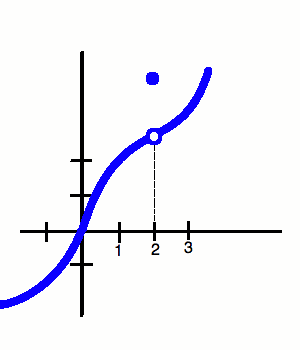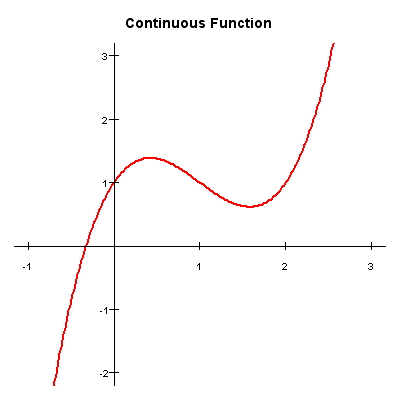 |
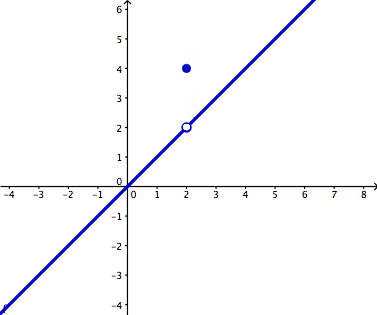 |
| Point Discontinuity |
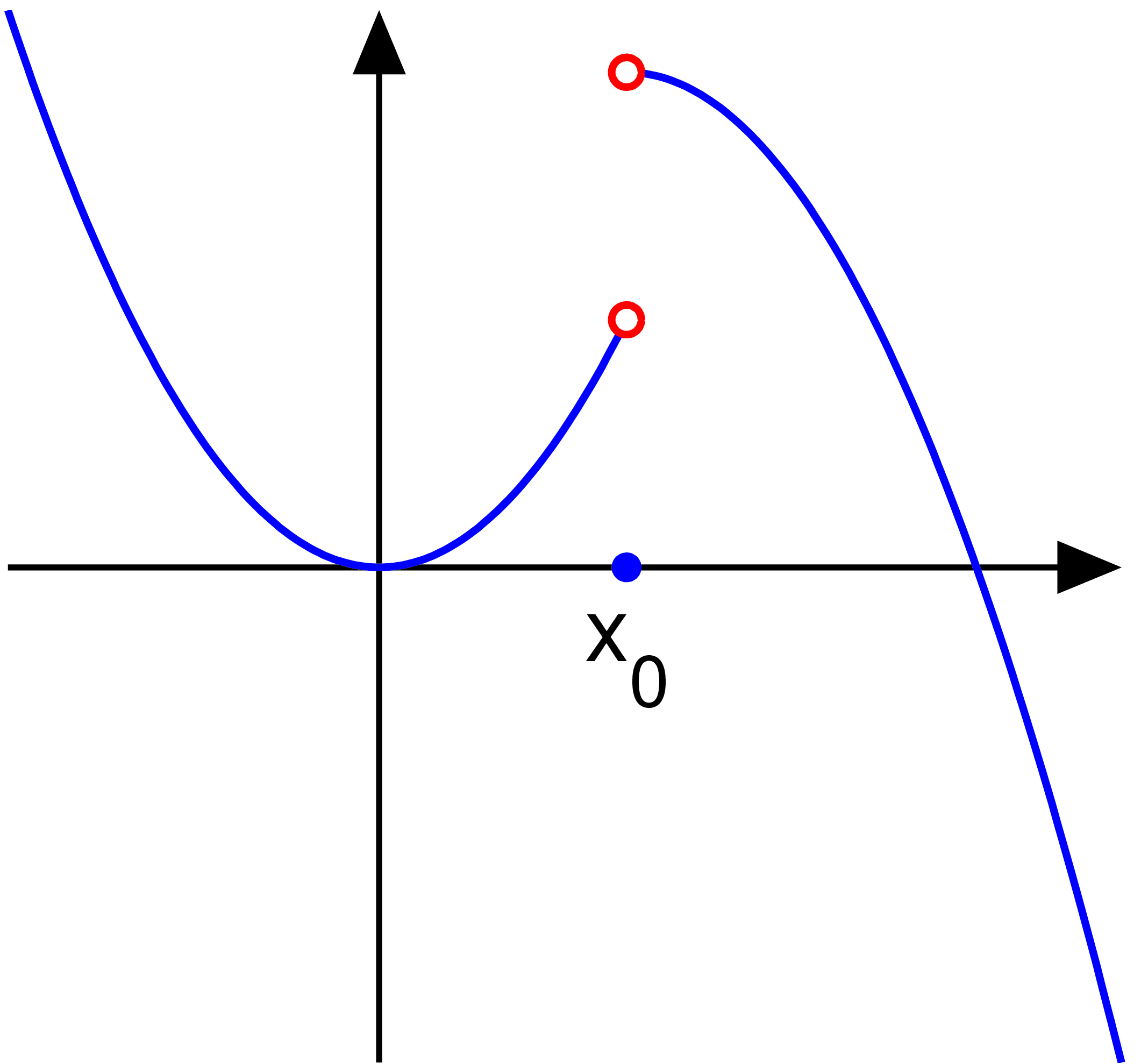 |
| Jump Discontinuity |
 |
| Oscillating Discontinuity |
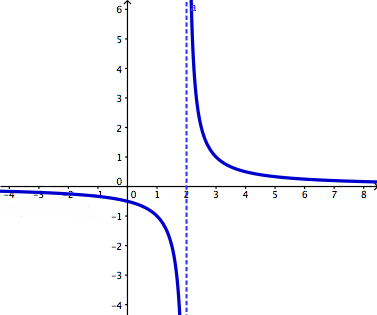 |
| Infinite Discontinuity |
A limit is the intended height of a function. It exists when both the left and the right meet at the same point. A limit does not exist when the left and the right do not meet at the same point, when there is unbounded behavior, and when there is oscillating behavior. A limit is the intended height of the function while the value is the actual height of the function.
As you can see in this picture, the limit is the intended height. The white circle in this function is a point discontinuity, the function intends to go to the white circle. Also if you use your left and right fingers to trace the left and right sides of the graph, you will meet at the same place, that is the limit. However, in this graph, the value is at a different place, the actual height of the function, the blue circle. In some cases, the limit and the value can be the same, like if the white circle had been a blue circle instead.
When evaluating limits numerically, we set up a table. When evaluating a limit graphically, we use a graph and use our fingers to trace the graph from the left and the right of the number we are approaching. When evaluating a graph algebraically, we are using the methods of substitution (plugging in a number, the number that x is approaching), factoring/dividing out (factoring out and canceling, plugging in answer into function), and rationalizing/conjugate (rationalizing/multiplying by conjugate, plugging back in answer into function).
| Numerically |
 |
| Graphically |
 |
| Substitution Method |
| Factoring/Dividing Method |
| Rationalizing/Conjugate Method |
Credit:
http://www.conservapedia.com/images/2/2f/Br-cont-function.png
http://dj1hlxw0wr920.cloudfront.net/userfiles/wyzfiles/4a69dec7-03e0-492f-ac16-4dcd555579c9.gif
http://upload.wikimedia.org/wikipedia/commons/e/e6/Discontinuity_jump.eps.png
http://webpages.charter.net/mwhitneyshhs/calculus/limits/limit-graph8.jpg
http://dj1hlxw0wr920.cloudfront.net/userfiles/wyzfiles/44bad38c-431e-4382-8fe9-86303561b2a0.gif
http://dj1hlxw0wr920.cloudfront.net/userfiles/wyzfiles/12cf828c-12be-4ace-a420-21bd21aeb8c8.gif
https://finitemathematics.wikispaces.hcpss.org/file/view/limit_table.PNG/239144381/575x194/limit_table.PNG
https://blogger.googleusercontent.com/img/b/R29vZ2xl/AVvXsEiCUbZ0eJareDU5yWUxAZMRubLi5PC81ZW3WVwF2aXfRHXfEWh3DjZD2e-_DGoW8kPbJplcMPVCYkCmk8Jr4s1Ons-PCsyQ1B-ExYnitDf2V-zX-wJHweCxVIttUGGOi61Kn2ma0rf_uZSZ/s400/LimitsGraphically011.jpg
http://evaluationoflimits.weebly.com/uploads/1/3/9/2/13920575/891412.jpg?424
http://00.edu-cdn.com/files/static/mcgrawhillprof/9780071624756/EVALUATING_LIMITS_09.GIF
http://00.edu-cdn.com/files/static/mcgrawhillprof/9780071624756/EVALUATING_LIMITS_11.GIF
http://upload.wikimedia.org/wikipedia/commons/e/e6/Discontinuity_jump.eps.png
http://webpages.charter.net/mwhitneyshhs/calculus/limits/limit-graph8.jpg
http://dj1hlxw0wr920.cloudfront.net/userfiles/wyzfiles/44bad38c-431e-4382-8fe9-86303561b2a0.gif
http://dj1hlxw0wr920.cloudfront.net/userfiles/wyzfiles/12cf828c-12be-4ace-a420-21bd21aeb8c8.gif
https://finitemathematics.wikispaces.hcpss.org/file/view/limit_table.PNG/239144381/575x194/limit_table.PNG
https://blogger.googleusercontent.com/img/b/R29vZ2xl/AVvXsEiCUbZ0eJareDU5yWUxAZMRubLi5PC81ZW3WVwF2aXfRHXfEWh3DjZD2e-_DGoW8kPbJplcMPVCYkCmk8Jr4s1Ons-PCsyQ1B-ExYnitDf2V-zX-wJHweCxVIttUGGOi61Kn2ma0rf_uZSZ/s400/LimitsGraphically011.jpg
http://evaluationoflimits.weebly.com/uploads/1/3/9/2/13920575/891412.jpg?424
http://00.edu-cdn.com/files/static/mcgrawhillprof/9780071624756/EVALUATING_LIMITS_09.GIF
http://00.edu-cdn.com/files/static/mcgrawhillprof/9780071624756/EVALUATING_LIMITS_11.GIF
